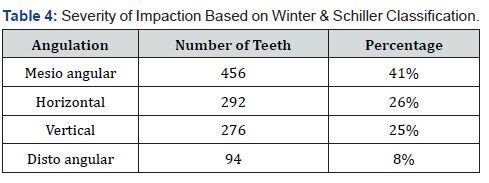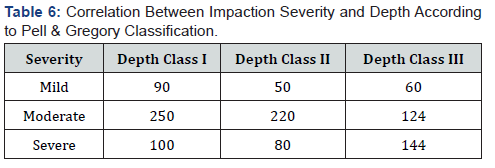Frequency and Severity of Impacted Mandibular Third Molars in Patients Visiting the Oral and Maxillofacial Surgery Department of Moscow Dental School, Russia
Mehran Feridouni* and Melika Tahan
Yevdokimov Moscow State University of Medicine and Dentistry (Semashko), Moscow, Russia
Submission: December 09, 2023; Published: January 03, 2024
*Corresponding author: Mehran Feridouni, Yevdokimov Moscow State University of Medicine and Dentistry (Semashko), Moscow, Russia
How to cite this article: Mehran Feridouni, Melika Tahan. Frequency and Severity of Impacted Mandibular Third Molars in Patients Visiting the Oral and Maxillofacial Surgery Department of Moscow Dental School, Russia. Adv Dent & Oral Health. 2024; 17(1): 555951. DOI: 10.19080/ADOH.2024.17.555951
Abstract
The presence of impacted third molars is a common phenomenon, and its prevalence and distribution vary significantly across different societies. The potential for complications in the absence of timely diagnosis and proper treatment of impacted mandibular third molars underscore the importance of this issue. This study aimed to determine the severity of impacted mandibular third molars in patients visiting the Moscow Dental School, Russia.
Keywords: Orthodontic Treatment; Adolescents; Dentistry; Malocclusion; Quality of Life
Introduction
The presence of impacted mandibular third molars is a prevalent condition with considerable variation in prevalence and distribution across different populations [1]. The potential for complications emphasizes the importance of timely diagnosis and appropriate treatment. This study aimed to assess the frequency and severity of impacted mandibular third molars in patients attending the Moscow Dental School. The presence of impacted mandibular third molars is a widespread phenomenon, exhibiting significant variability in both prevalence and distribution among diverse populations [2,3]. Timely diagnosis and proper treatment are paramount due to the potential complications associated with impacted molars. This study seeks to contribute to the existing body of knowledge by evaluating the frequency and severity of impacted mandibular third molars specifically among patients attending the Moscow Dental School in Russia. Impacted third molars, also known as wisdom teeth, are the last set of molars located at the back of the mouth. Their impact occurs when these molars do not fully emerge through the gum line, leading to various complications such as pain, infection [4], and potential damage to adjacent teeth. The prevalence and characteristics of impacted molars can vary significantly across different populations, influenced by factors such as genetics, demographics, and environmental conditions [5]. While numerous studies have investigated impacted molars in various global settings, there is a scarcity of research specifically addressing this issue in the context of Moscow, Russia.
Therefore, this study aims to fill this gap in the literature by focusing on patients attending the Moscow Dental School. Understanding the unique patterns of impaction in this population can provide valuable insights for clinicians, researchers, and policymakers, ultimately enhancing dental care strategies and improving patient outcomes [5]. By assessing both the frequency and severity of impacted mandibular third molars, this research contributes not only to the academic understanding of oral health but also to the practical implications for dental professionals in Moscow. The findings may guide the development of targeted screening programs, early intervention protocols, and personalized treatment plans tailored to the unique characteristics of impacted molars in this specific population [5,6]. In summary, this study addresses the need for localized research on impacted mandibular third molars by focusing on patients attending the Moscow Dental School. The investigation aims to unravel the prevalence and severity of impaction in this population, fostering a better understanding of oral health challenges and paving the way for improved dental care practices in the region.
Methods
A cross-sectional descriptive study was conducted, involving the examination of 743 patients at the Oral and Maxillofacial Surgery Center of Moscow Dental School from October to February 2017. Panoramic radiography was utilized to record and determine the position, angulation, and severity of impaction of mandibular third molars (Tables 1-6).






Results
Out of 1118 impacted mandibular third molars, 41% were in mesio angular position, 26% in horizontal position, 25% in vertical position, and 8% in disto angular position. Females exhibited a higher prevalence of impacted molars (58%). The most frequently observed impaction severity was of moderate degree (53%). While no significant correlation was found between gender and impaction severity, a significant association existed between gender and the angulation of impacted mandibular third molars based on the Winter & Schiller classification [7]. Moreover, impaction severity correlated significantly with the depth of impaction and its association with the Pell & Gregory classification (p<0.001). The findings of this study provide valuable insights into the prevalence and characteristics of impacted mandibular third molars among patients at the Moscow Dental School. The high prevalence of impacted molars, particularly in the mesio angular position, highlights the significance of proactive screening and early intervention [8]. The gender-based differences in impaction prevalence warrant further investigation to understand potential contributing factors. The observed correlation between gender and the angulation of impacted mandibular third molars according to the Winter & Schiller classification is noteworthy [9]. This suggests that there may be gender-specific anatomical or developmental factors influencing the orientation of impacted molars. Further research could explore these factors in greater detail to enhance our understanding of impaction patterns. The significant association between impaction severity and the depth of impaction, as determined by the Pell & Gregory classification [10], underscores the importance of a comprehensive assessment. This information can guide clinicians in tailoring treatment plans based on the severity and depth of impact, promoting more personalized and effective care. The study’s limitations include its cross-sectional design, which provides a snapshot of impaction prevalence and characteristics at a specific point in time. Longitudinal studies could offer insights into the dynamic nature of impact and its potential changes over time. Additionally, exploring the impact of socio-demographic factors on impaction prevalence could enhance our understanding of the broader influences on oral health.
In conclusion, the findings of this study shed light on the prevalence and characteristics of impacted mandibular third molars among patients at the Moscow Dental School in Russia. The notable frequency of impacted molars, particularly in the mesio angular position, underscores the necessity of routine screening and early intervention programs to address these dental challenges. The study also highlights gender-based differences in impaction patterns, suggesting potential anatomical or developmental influences that merit further exploration. The observed correlation between impaction severity and the depth of impaction according to the Pell & Gregory classification adds an essential layer of information for clinicians. This correlation can guide treatment planning by considering both the severity and depth of impact, leading to more precise and individualized patient care [10,11]. While this study provides valuable insights, it is crucial to acknowledge its limitations. The cross-sectional design offers a static view of impaction prevalence, and future longitudinal studies could provide a more dynamic understanding of how impaction patterns may evolve over time. Furthermore, exploring the influence of socio-demographic factors on impaction prevalence could enhance our comprehension of the broader determinants of oral health in this population (5). The implications of this research extend beyond academic interest to practical applications in dental care. Proactive measures such as early detection, proper diagnosis, and timely intervention can significantly reduce the potential complications associated with impacted third molars, ultimately improving the overall oral health and quality of life for patients [12].
This study sets the stage for further research endeavors aimed at unraveling the intricate factors contributing to impaction and exploring additional dimensions such as genetic predispositions, environmental influences, and lifestyle factors. Additionally, investigating the long-term consequences of impacted molars on oral health and overall well-being can provide a more comprehensive understanding of the challenges posed by this prevalent dental condition [1,13]. In summary, this research contributes valuable knowledge to the field of oral and maxillofacial surgery, specifically addressing the prevalence and severity of impacted mandibular third molars in the Moscow Dental School patient population. The findings emphasize the importance of tailored dental care strategies and lay the groundwork for future studies that delve deeper into the multifaceted aspects of impacted molars.
Conclusion
This study reveals a relatively high prevalence of impacted mandibular third molars with a moderate degree of severity among patients at the Moscow Dental School. These findings underscore the importance of implementing screening programs, ensuring timely diagnosis, and providing appropriate treatment for impacted third molars.
References
- Nabahat H, Rajabi A, Zaeri N, Tahan M, Mohammadi MM, et al. (2022) Evaluation of Frequency, Degree of Lower Wisdom Tooth Occlusion and Complications after Surgery in 90 Patients. Adv Dent Oral Health 15(5).
- Stella Sekulić, Mike TJ, Katrin B, Mohammad H Al-Harth, Ambra M, et al. (2021) Frequency of Four-Dimensional Oral Health Problems Across Dental Fields–A Comparative Survey of Slovenian and International Dentists. Zdr Varst 60(4): 210-220.
- Chantaracherd P, Sekulić S, John MT, Mohammad H Al-Harth, Ambra M, et al. (2021) Frequency of four-dimensional oral health problems across dental fields-A comparative survey of Slovenian and international dentists. Zdr Varst 60(4): 210-220.
- Costa L, Sarmento V, Rubira-Bullen I, Araujo G, Borges E, et al. (2017) Wednesday, 30 August 2017 WDC 2017–Abstract BooK free Communication Sessions 25-48 and poster sessions 25-47. Int Dental J 67(1): 68-134.
- Corridore D, Giannetti C, Giordano G, Solidani M, Ottolenghi L (2011) Dental erosion in patients with gastro-esophageal reflux disease (GERD). Annali Di Stomatologia p. 43.
- Negrello S, Anesi A, Casadei M, Chiarini L (2016) Orbital approaches for primary and secondary tumours. 23° Congress of European Association for Cranio-Maxillofacial Surgery (EACMFS).
- Markarov A, Eremin D, Martirosov A, Khandzratsyan A, Orazvaliev A, et al. (2023) Statistical analysis of Data on Emergency Maxillofacial Surgery. Bullet Russia State Medical University 2023(5): 56-62.
- Damiani G, Poli P, Pacifico A, Rosi E, Allocca G, et al. (2023) The Relevant Oral Burden of Patients with Hidradenitis Suppurativa. Dermatol Ther 13(10): 2319-2329.
- Koposova NV (2013) Oral health among children in the Barents region: study on determinants of child’s oral health, their oral related quality of life and quality of dental care.
- Vodanović M (2014) Programme and book of abstracts of the 16th International Symposium on Dental Morphology and 1st Congress of the International Association for Paleodontology, August 26-30, 2014, Zagreb, Croatia. Bullet Int Associat Paleodontol 8(1): 1-184.
- Van Hout MC, Hearne E (2014) Oral health behaviours amongst homeless people attending rehabilitation services in Ireland. J Ir Dent Assoc 60(3): 144-149.
- Yen SLK, Gross J, Yamashita DD, Kim TH, McAndrews J, et al. (2002) Correcting an anterior open-bite side effect during distraction with spring forces. Plast Reconstr Surg 110(6): 1476-1484.
- Nabahat H, Azaditalab Davoudabadi F, Tahan M, Asakereh S, Boroumand Z, et al. (2022) The Effect of Impacted Wisdom Tooth Surgery on The Rate of Mouth Opening.






























